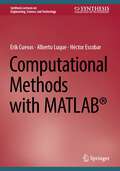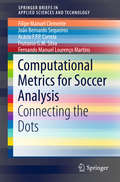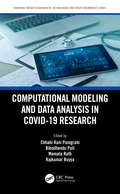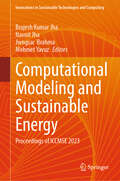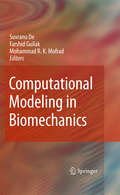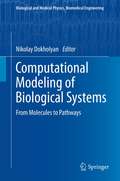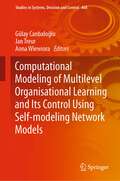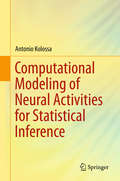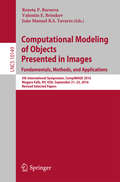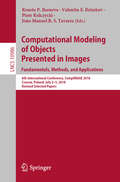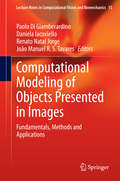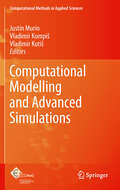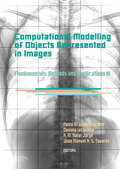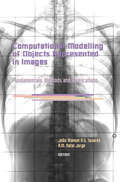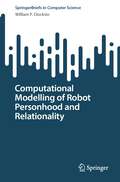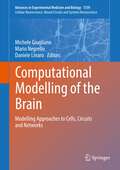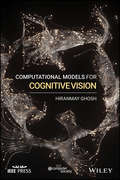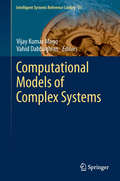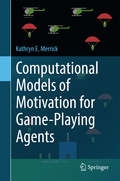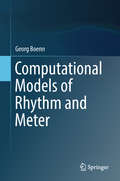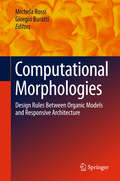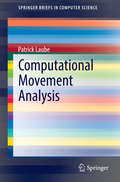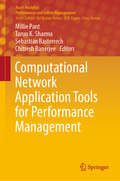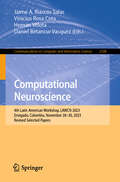- Table View
- List View
Computational Methods with MATLAB® (Synthesis Lectures on Engineering, Science, and Technology)
by Erik Cuevas Alberto Luque Héctor EscobarThis textbook provides readers a comprehensive introduction to numerical methods, using MATLAB®. The authors discuss the theory and application of the most often used numerical methods, using MATLAB as a computational tool. The book is designed to be accessible to readers of varying backgrounds, so the presentation focuses more on the description, implementation, and application of the methods and less on the mathematical details. This book not only covers the most important methods and techniques of scientific computation, but also contains a great amount of code and implementations, facilitating the process of learning and application.
Computational Metrics for Soccer Analysis: Connecting the dots (SpringerBriefs in Applied Sciences and Technology)
by Filipe Manuel Clemente João Bernardo Sequeiros Acácio F. P. P. Correia Frutuoso G. M. Silva Fernando Manuel Lourenço MartinsThis book provides an account of the use of computational tactical metrics in improving sports analysis, in particular the use of Global Positioning System (GPS) data in soccer. As well as offering a practical perspective on collective behavioural analysis, it introduces the computational metrics available in the literature that allow readers to identify collective behaviour and patterns of play in team sports. These metrics only require the bio-dimensional geo-referencing information from GPS or video-tracking systems to provide qualitative and quantitative information about the tactical behaviour of players and the inter-relationships between teammates and their opponents. Exercises, experimental cases and algorithms enable readers to fully comprehend how to compute these metrics, as well as introducing them to the ultimate performance analysis tool, which is the basis to run them on. The script to compute the metrics is presented in Python. The book is a valuable resource for professional analysts as well students and researchers in the field of sports analysis wanting to optimise the use of GPS trackers in soccer.
Computational Modeling and Data Analysis in COVID-19 Research (Emerging Trends in Biomedical Technologies and Health informatics)
by Chhabi Rani Panigrahi, Bibudhendu Pati, Mamata Rath and Rajkumar BuyyaThis book covers recent research on the COVID-19 pandemic. It includes the analysis, implementation, usage, and proposed ideas and models with architecture to handle the COVID-19 outbreak. Using advanced technologies such as artificial intelligence (AI) and machine learning (ML), techniques for data analysis, this book will be helpful to mitigate exposure and ensure public health. We know prevention is better than cure, so by using several ML techniques, researchers can try to predict the disease in its early stage and develop more effective medications and treatments. Computational technologies in areas like AI, ML, Internet of Things (IoT), and drone technologies underlie a range of applications that can be developed and utilized for this purpose. Because in most cases there is no one solution to stop the spreading of pandemic diseases, and the integration of several tools and tactics are needed. Many successful applications of AI, ML, IoT, and drone technologies already exist, including systems that analyze past data to predict and conclude some useful information for controlling the spread of COVID-19 infections using minimum resources. The AI and ML approach can be helpful to design different models to give a predictive solution for mitigating infection and preventing larger outbreaks. This book: Examines the use of artificial intelligence (AI), machine learning (ML), Internet of Things (IoT), and drone technologies as a helpful predictive solution for controlling infection of COVID-19 Covers recent research related to the COVID-19 pandemic and includes the analysis, implementation, usage, and proposed ideas and models with architecture to handle a pandemic outbreak Examines the performance, implementation, architecture, and techniques of different analytical and statistical models related to COVID-19 Includes different case studies on COVID-19 Dr. Chhabi Rani Panigrahi is Assistant Professor in the Department of Computer Science at Rama Devi Women’s University, Bhubaneswar, India. Dr. Bibudhendu Pati is Associate Professor and Head of the Department of Computer Science at Rama Devi Women’s University, Bhubaneswar, India. Dr. Mamata Rath is Assistant Professor in the School of Management (Information Technology) at Birla Global University, Bhubaneswar, India. Prof. Rajkumar Buyya is a Redmond Barry Distinguished Professor and Director of the Cloud Computing and Distributed Systems (CLOUDS) Laboratory at the University of Melbourne, Australia.
Computational Modeling and Sustainable Energy: Proceedings of ICCMSE 2023 (Innovations in Sustainable Technologies and Computing)
by Brajesh Kumar Jha Navnit Jha Jwngsar Brahma Mehmet YavuzThis book features best-selected research papers presented at International Conference on Computational Modeling and Sustainable Energy (ICCMSE 2023) held at Pandit Deendayal Energy University, Gandhinagar, Gujarat, India, during December 15–17, 2023. It comprises high-quality research work by academicians and industrial experts in the field of machine learning, mobile computing, natural language processing, fuzzy computing, green computing, human–computer interaction, information retrieval, intelligent control, data mining and knowledge discovery, evolutionary computing, big data, cloud computing, business intelligence, Internet security, pattern recognition, and sustainable energy.
Computational Modeling in Biomechanics
by Suvranu De Farshid Guilak Mohammad MofradAvailability of advanced computational technology has fundamentally altered the investigative paradigm in the field of biomechanics. Armed with sophisticated computational tools, researchers are seeking answers to fundamental questions by exploring complex biomechanical phenomena at the molecular, cellular, tissue and organ levels. The computational armamentarium includes such diverse tools as the ab initio quantum mechanical and molecular dynamics methods at the atomistic scales and the finite element, boundary element, meshfree as well as immersed boundary and lattice-Boltzmann methods at the continuum scales. Multiscale methods that link various scales are also being developed. While most applications require forward analysis, e.g., finding deformations and stresses as a result of loading, others involve determination of constitutive parameters based on tissue imaging and inverse analysis. This book provides a glimpse of the diverse and important roles that modern computational technology is playing in various areas of biomechanics including biofluids and mass transfer, cardiovascular mechanics, musculoskeletal mechanics, soft tissue mechanics, and biomolecular mechanics.
Computational Modeling of Biological Systems: From Molecules to Pathways (Biological and Medical Physics, Biomedical Engineering)
by Nikolay V DokholyanComputational modeling is emerging as a powerful new approach to study and manipulate biological systems. Multiple methods have been developed to model, visualize, and rationally alter systems at various length scales, starting from molecular modeling and design at atomic resolution to cellular pathways modeling and analysis. Higher time and length scale processes, such as molecular evolution, have also greatly benefited from new breeds of computational approaches. This book provides an overview of the established computational methods used for modeling biologically and medically relevant systems.
Computational Modeling of Cognition and Behavior
by Simon Farrell Stephan LewandowskyComputational modeling is now ubiquitous in psychology, and researchers who are not modelers may find it increasingly difficult to follow the theoretical developments in their field. This book presents an integrated framework for the development and application of models in psychology and related disciplines. Researchers and students are given the knowledge and tools to interpret models published in their area, as well as to develop, fit, and test their own models. Both the development of models and key features of any model are covered, as are the applications of models in a variety of domains across the behavioural sciences. A number of chapters are devoted to fitting models using maximum likelihood and Bayesian estimation, including fitting hierarchical and mixture models. Model comparison is described as a core philosophy of scientific inference, and the use of models to understand theories and advance scientific discourse is explained. Covers both basic and advanced topics to appeal to students and researchers alike. Provides a framework for using models in a variety of domains across psychology and related disciplines. Describes the application of models by walking through code written in R, a popular and free statistical programming language
Computational Modeling of Multilevel Organisational Learning and Its Control Using Self-modeling Network Models (Studies in Systems, Decision and Control #468)
by Jan Treur Gülay Canbaloğlu Anna WiewioraAlthough there is much literature on organisational learning, mathematical formalisation and computational simulation, there is no literature that uses mathematical modelling and simulation to represent and explore different facets of multilevel learning. This book provides an overview of recent work on mathematical formalisation and computational simulation of multilevel organisational learning by exploiting the possibilities of self-modeling network models to address it. This is the first book addressing mathematical formalisation and computational modeling of multilevel organisational learning in a systematic, principled manner. A self-modeling network modeling approach from AI and Network Science is used where in a reflective manner some of the network nodes (called self-model nodes) represent parts of the network’s own network structure characteristics. This is supported by a dedicated software environment allowing to design and implement (higher-order) adaptive network models by specifying them in a conceptual manner at a high level of abstraction in a standard table format, without any need of algorithmic specification or programming. This modeling approach allows to model the development of knowledge in an organisational setting in a neatly structured manner at three different levels for the usage, adaptation and control, respectively, of the underlying mental models. Several examples of realistic cases of multilevel organisational learning are used to illustrate the approach. Crucial concepts such as the aggregation of mental models to form shared mental models out of individual mental models are addressed extensively. It is shown how to model context-sensitive control of organisational learning taking into account a wide variety of context factors, for example relating to levels of expertise of individuals or to leadership styles of managers involved. Mathematical equilibrium analysis of models of organisational learning is also addressed, among others allowing verification of correctness of the implemental models in comparison to their conceptual design. Chapters in this book also contribute to the Management and Business Sciences research by demonstrating how computational modeling can be used to capture complex management phenomena such as multilevel organizational learning. This book has a potential implication for practice by demonstrating how computational modeling can be used to capture learning scenarios, which then provide a basis for more informed managerial decisions.
Computational Modeling of Neural Activities for Statistical Inference
by Antonio KolossaThis authored monograph supplies empirical evidence for the Bayesian brain hypothesis by modeling event-related potentials (ERP) of the human electroencephalogram (EEG) during successive trials in cognitive tasks. The employed observer models are useful to compute probability distributions over observable events and hidden states, depending on which are present in the respective tasks. Bayesian model selection is then used to choose the model which best explains the ERP amplitude fluctuations. Thus, this book constitutes a decisive step towards a better understanding of the neural coding and computing of probabilities following Bayesian rules. The target audience primarily comprises research experts in the field of computational neurosciences, but the book may also be beneficial for graduate students who want to specialize in this field.
Computational Modeling of Objects Presented in Images. Fundamentals, Methods, and Applications: 5th International Symposium, CompIMAGE 2016, Niagara Falls, NY, USA, September 21-23, 2016, Revised Selected Papers (Lecture Notes in Computer Science #10149)
by Reneta P. Barneva Valentin E. Brimkov João Manuel R.S. TavaresThis book constitutes the refereed post-conference proceedings of the 5th International Conference on Computational Modeling of Objects Presented in Images, CompIMAGE 2016, held in Niagara Falls, NY, USA, in September 2016. The 18 revised full papers presented together with 1 invited paper were carefully reviewed and selected from 30 submissions. The papers cover the following topics: theoretical contributions and application-driven contributions.
Computational Modeling of Objects Presented in Images. Fundamentals, Methods, and Applications: 6th International Conference, CompIMAGE 2018, Cracow, Poland, July 2–5, 2018, Revised Selected Papers (Lecture Notes in Computer Science #10986)
by Reneta P. Barneva Valentin E. Brimkov Piotr Kulczycki João Manuel TavaresThis book constitutes the refereed post-conference proceedings of the 6th International Symposium on Computational Modeling of Objects Presented in Images, CompIMAGE 2018, held in Cracow, Poland, inJuly 2018.The 16 revised full papers presented in this book were carefully reviewed and selected from 30 submissions. The papers cover the following topics: digital geometry; digital tomography; and methods and applications.
Computational Modeling of Objects Presented in Images: Fundamentals, Methods and Applications (Lecture Notes in Computational Vision and Biomechanics #15)
by João Manuel R. S. Tavares Daniela Iacoviello Paolo Giamberardino Renato Natal JorgeThis book contains extended versions of selected papers from the 3rd edition of the International Symposium CompIMAGE. These contributions include cover methods of signal and image processing and analysis to tackle problems found in medicine, material science, surveillance, biometric, robotics, defence, satellite data, traffic analysis and architecture, image segmentation, 2D and 3D reconstruction, data acquisition, interpolation and registration, data visualization, motion and deformation analysis and 3D vision.
Computational Modelling and Advanced Simulations (Computational Methods in Applied Sciences #24)
by Justín Murín Vladimír Kompiš Vladimír KutišThis book contains selected, extended papers presented at the thematic ECCOMAS conference on Computational Modelling and Advanced Simulations (CMAS2009) held in Bratislava, Slovakia, June 30 - July 3, 2009. Modelling and simulation of engineering problems play a very important role in the classic and new composite material sciences, and in design and computational prototyping of modern and advanced technologic parts and systems. According to this, the existing numerical methods have been improved and new numerical methods have been established for modelling and simulation of more and more complex and complicated engineering problems. The present book should contribute to the effort to make modelling and simulation more effective and accurate.
Computational Modelling of Objects Represented in Images III: Fundamentals, Methods and Applications
by Paolo Di Giamberardino & Daniela Iacoviello R.M. Natal Jorge & João Manuel R.S. TavaresComputational Modelling of Objects Represented in Images: Fundamentals, Methods and Applications III contains all contributions presented at the International Symposium CompIMAGE 2012 - Computational Modelling of Object Presented in Images: Fundamentals, Methods and Applications (Rome, Italy, 5-7 September 2012). The contributions cover the state-o
Computational Modelling of Objects Represented in Images. Fundamentals, Methods and Applications: Proceedings of the International Symposium CompIMAGE 2006 (Coimbra, Portugal, 20-21 October 2006) (Lecture Notes In Computer Science / Image Processing, Computer Vision, Pattern Recognition, And Graphics Ser.)
by João Manuel R.S. Tavares R.M. Natal JorgeThis book contains keynote lectures and full papers presented at the International Symposium on Computational Modelling of Objects Represented in Images (CompIMAGE), held in Coimbra, Portugal, on 20-21 October 2006. International contributions from nineteen countries provide a comprehensive coverage of the current state-of-the-art in the fields of: - Image Processing and Analysis; - Image Segmentation; - Data Interpolation; - Registration, Acquisition and Compression; - 3D Reconstruction; - Objects Tracking; - Motion and Deformation Analysis; - Objects Simulation; - Medical Imaging; - Computational Bioimaging and Visualization. Related techniques also covered in this book include the finite element method, modal analyses, stochastic methods, principal and independent components analyses and distribution models. Computational Modelling of Objects Represented in Images will be useful to academics, researchers and professionals in Computational Vision (image processing and analysis), Computer Sciences, and Computational Mechanics.
Computational Modelling of Robot Personhood and Relationality (SpringerBriefs in Computer Science)
by William F. ClocksinThis SpringerBrief is a computational study of significant concerns and their role in forming long-term relationships between intelligent entities. Significant concerns include attitudes, preferences, affinities, and values that are held to be highly valued and meaningful: The means through which a person may find deeply held identity, purpose, and transformation. Significant concerns always engage the emotions and senses in a way that simply holding an opinion may or may not. For example, experiencing a significant concern may provoke deep feelings of awe and wonder in a way that deciding what to have for lunch probably does not, even if the lunch decision involves a rich array of preferences and values. Significant concerns also include what Emmons has called ultimate concerns. The author builds upon this base by considering the hypothetical case of intelligence in androids. An android is defined as a human-like robot that humans would accept as equal to humans in how they perform and behave in society. An android as defined in this book is not considered to be imitating a human, nor is its purpose to deceive humans into believing that it is a human. Instead, the appropriately programmed android self-identifies as a non-human with its own integrity as a person. Therefore, a computational understanding of personhood and how persons – whether human or android – participate in relationships is essential to this perspective on artificial intelligence. Computational Modelling of Robot Personhood and Relationality describes in technical detail an implementation of a computational model called Affinity that takes the form of a simulation of a population of entities that form, maintain, and break relationships with each other depending upon a rich range of values, motivations, attitudes, and beliefs. Future experimentation and improvements of this model may be used not only to gain a wider understanding of human persons but may also form a preliminary cognitive model of the reasoning process of an android.
Computational Modelling of the Brain: Modelling Approaches to Cells, Circuits and Networks (Advances in Experimental Medicine and Biology #1359)
by Mario Negrello Michele Giugliano Daniele LinaroThis volume offers an up-to-date overview of essential concepts and modern approaches to computational modelling, including the use of experimental techniques related to or directly inspired by them. The book introduces, at increasing levels of complexity and with the non-specialist in mind, state-of-the-art topics ranging from single-cell and molecular descriptions to circuits and networks.Four major themes are covered, including subcellular modelling of ion channels and signalling pathways at the molecular level, single-cell modelling at different levels of spatial complexity, network modelling from local microcircuits to large-scale simulations of entire brain areas and practical examples. Each chapter presents a systematic overview of a specific topic and provides the reader with the fundamental tools needed to understand the computational modelling of neural dynamics. This book is aimed at experimenters and graduate students with little or no prior knowledge of modelling who are interested in learning about computational models from the single molecule to the inter-areal communication of brain structures. The book will appeal to computational neuroscientists, engineers, physicists and mathematicians interested in contributing to the field of neuroscience.Chapters 6, 10 and 11 are available open access under a Creative Commons Attribution 4.0 International License via link.springer.com.
Computational Models for Cognitive Vision
by Hiranmay GhoshLearn how to apply cognitive principles to the problems of computer vision Computational Models for Cognitive Vision formulates the computational models for the cognitive principles found in biological vision, and applies those models to computer vision tasks. Such principles include perceptual grouping, attention, visual quality and aesthetics, knowledge-based interpretation and learning, to name a few. The author’s ultimate goal is to provide a framework for creation of a machine vision system with the capability and versatility of the human vision. Written by Dr. Hiranmay Ghosh, the book takes readers through the basic principles and the computational models for cognitive vision, Bayesian reasoning for perception and cognition, and other related topics, before establishing the relationship of cognitive vision with the multi-disciplinary field broadly referred to as “artificial intelligence”. The principles are illustrated with diverse application examples in computer vision, such as computational photography, digital heritage and social robots. The author concludes with suggestions for future research and salient observations about the state of the field of cognitive vision. Other topics covered in the book include: · knowledge representation techniques · evolution of cognitive architectures · deep learning approaches for visual cognition Undergraduate students, graduate students, engineers, and researchers interested in cognitive vision will consider this an indispensable and practical resource in the development and study of computer vision.
Computational Models of Complex Systems (Intelligent Systems Reference Library #53)
by Vahid Dabbaghian Vijay Kumar MagoComputational and mathematical models provide us with the opportunities to investigate the complexities of real world problems. They allow us to apply our best analytical methods to define problems in a clearly mathematical manner and exhaustively test our solutions before committing expensive resources. This is made possible by assuming parameter(s) in a bounded environment, allowing for controllable experimentation, not always possible in live scenarios. For example, simulation of computational models allows the testing of theories in a manner that is both fundamentally deductive and experimental in nature. The main ingredients for such research ideas come from multiple disciplines and the importance of interdisciplinary research is well recognized by the scientific community. This book provides a window to the novel endeavours of the research communities to present their works by highlighting the value of computational modelling as a research tool when investigating complex systems. We hope that the readers will have stimulating experiences to pursue research in these directions.
Computational Models of Motivation for Game-Playing Agents
by Kathryn E. MerrickThe focus of this book is on three influentialcognitive motives: achievement, affiliation, and power motivation. Incentive-based theories of achievement, affiliation and power motivation arethe basis for competence-seeking behaviour, relationship-building, leadership,and resource-controlling behaviour in humans. In this book we show how thesemotives can be modelled and embedded in artificial agents to achievebehavioural diversity. Theoretical issues are addressed for representing andembedding computational models of motivation in rule-based agents, learningagents and evolutionary agents. Practical issues are addressed for defininggames, mini-games or in-game scenarios for virtual worlds in whichcomputer-controlled, motivated agents can participate alongside human players. The book is structured into four parts: game playingin virtual worlds by humans and agents; comparing human and artificial motivesin rule-based agents; game scenarios for motivated learning agents; andevolution and the future of motivated game playing agents. It will provide gameprogrammers, and those with an interest in artificial intelligence, with theknowledge required to develop diverse, believable game playing agents forvirtual worlds.
Computational Models of Rhythm and Meter
by Georg BoennThis book presents the latest computational models of rhythm and meter that are based on number theory, combinatorics and pattern matching. Two computational models of rhythm and meter are evaluated: The first one explores a relatively new field in Mathematics, namely Combinatorics on Words, specifically Christoffel Words and the Burrows-Wheeler Transform, together with integer partitions. The second model uses filtered Farey Sequences in combination with specific weights that are assigned to inter-onset ratios. This work is assessed within the context of the current state of the art of tempo tracking and computational music transcription. Furthermore, the author discusses various representations of musical rhythm, which lead to the development of a new shorthand notation that will be useful for musicologists and composers. Computational Models of Rhythm and Meter also contains numerous investigations into the timing structures of human rhythm and metre perception carried out within the last decade. Our solution to the transcription problem has been tested using a wide range of musical styles, and in particular using two recordings of J.S. Bach's Goldberg Variations by Glenn Gould. The technology is capable of modelling musical rhythm and meter by using Farey Sequences, and by detecting duration classes in a windowed analysis, which also detects the underlying tempo. The outcomes represent human performances of music as accurate as possible within Western score notation.
Computational Morphologies: Design Rules Between Organic Models and Responsive Architecture
by Michela Rossi Giorgio BurattiThis book represents an invaluable and up-to-date international exchange of research, case studies and best practice to tackle the challenges of digital technology, computer-aided design, 3D modeling, prototyping machines and computational design. With contributions from leading experts in the field of industrial design and cultural heritage, it is split into three parts. The first part explores basic rules of design, design models and shape grammar, including the management of complex forms, and proves that innovative concepts may be derived from organic models using generative design. The second part then investigates responsive design, describing how to manage the changing morphologies of buildings through pre-programmed mechanisms of real-time response and feedback embedded in inhabitable spaces. Lastly, the third part focuses on digital heritage and its capability to increase the interaction and manipulation of object and concepts, ranging from augmented reality to modeling generative tools. The book gathers peer-reviewed papers presented at the eCAADe (Education and Research in Computer-Aided Architectural Design in Europe) Regional International Symposium, held in Milan, Italy, in 2015.
Computational Movement Analysis (SpringerBriefs in Computer Science)
by Patrick LaubeThis SpringerBrief discusses the characteristics of spatiotemporal movement data, including uncertainty and scale. It investigates three core aspects of Computational Movement Analysis: Conceptual modeling of movement and movement spaces, spatiotemporal analysis methods aiming at a better understanding of movement processes (with a focus on data mining for movement patterns), and using decentralized spatial computing methods in movement analysis. The author presents Computational Movement Analysis as an interdisciplinary umbrella for analyzing movement processes with methods from a range of fields including GIScience, spatiotemporal databases and data mining. Key challenges in Computational Movement Analysis include bridging the semantic gap, privacy issues when movement data involves people, incorporating big and open data, and opportunities for decentralized movement analysis arising from the internet of things. The interdisciplinary concepts of Computational Movement Analysis make this an important book for professionals and students in computer science, geographic information science and its application areas, especially movement ecology and transportation research.
Computational Network Application Tools for Performance Management (Asset Analytics)
by Millie Pant Tarun K. Sharma Sebastián Basterrech Chitresh BanerjeeThis book explores a range of important theoretical and practical issues in the field of computational network application tools, while also presenting the latest advances and innovations using intelligent technology approaches. The main focus is on detecting and diagnosing complex application performance problems so that an optimal and expected level of system service can be attained and maintained. The book discusses challenging issues like enhancing system efficiency, performance, and assurance management, and blends the concept of system modeling and optimization techniques with soft computing, neural network, and sensor network approaches. In addition, it presents certain metrics and measurements that can be translated into business value. These metrics and measurements can also help to establish an empirical performance baseline for various applications, which can be used to identify changes in system performance. By presenting various intelligent technologies, the book provides readers with compact but insightful information on several broad and rapidly growing areas in the computation network application domain.The book’s twenty-two chapters examine and address current and future research topics in areas like neural networks, soft computing, nature-inspired computing, fuzzy logic and evolutionary computation, machine learning, smart security, and wireless networking, and cover a wide range of applications from pattern recognition and system modeling, to intelligent control problems and biomedical applications. The book was written to serve a broad readership, including engineers, computer scientists, management professionals, and mathematicians interested in studying tools and techniques for computational intelligence and applications for performance analysis. Featuring theoretical concepts and best practices in computational network applications, it will also be helpful for researchers, graduate and undergraduate students with an interest in the fields of soft computing, neural networks, machine learning, sensor networks, smart security, etc.
Computational Neuroscience: 4th Latin American Workshop, LAWCN 2023, Envigado, Colombia, November 28–30, 2023, Revised Selected Papers (Communications in Computer and Information Science #2108)
by Vinícius Rosa Cota Jaime A. Riascos Salas Hernán Villota Daniel Betancur VasquezThis book constitutes the refereed proceedings of the 4th Latin American Workshop, LAWCN 2023, held in Envigado, Colombia, during November 28–30, 2023. The 8 full papers and 2 short papers included in this book were carefully reviewed and selected from 50 submissions. They were organized in topical sections as follows: artificial intelligence and machine learning; computational neuroscience; and brain-computer interfaces.
